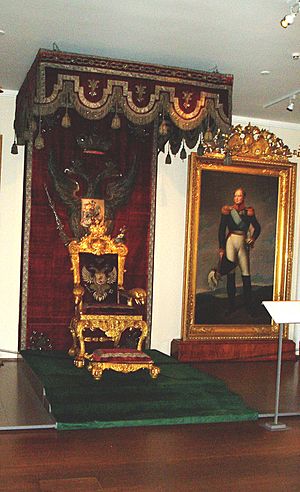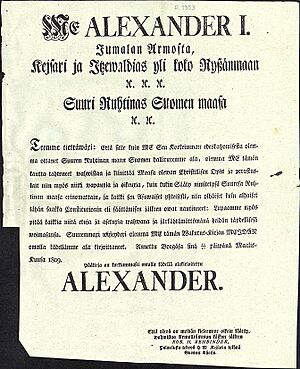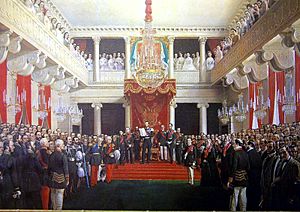Diet of Finland facts for kids
The Diet of Finland was like an old parliament or a meeting of important people in Finland. It was the main law-making group for the Grand Duchy of Finland from 1809 to 1906. Before that, Finland was part of Sweden, and the Diet took over the powers of the Swedish parliament. Today, the word valtiopäivät in Finnish means a yearly meeting of the modern Parliament of Finland.
Contents
Early Meetings in Finland
The very first meetings of important groups in Finland happened a long time ago. One of the earliest known meetings of Finnish representatives was in Helsinki in 1616. Other meetings, called Åbo Lantdag, were held in Turku. For example, one took place in 1676. These early meetings helped set the stage for the later Diet of Finland.
The Important Porvoo Diet
A very important meeting called the Porvoo Diet happened during the Finnish War. This was when Sweden and Russia were fighting, and Russia took over Finland. The new ruler, Tsar Alexander I, who became the Grand Duke of Finland, called together four main groups of people from Finland. These groups were:
- The Nobility (important families)
- The Clergy (church leaders)
- The Bourgeoisie (city business people)
- The Peasants (farmers and rural people)
They met in Porvoo from March to July 1809. The most important moment was on March 29, when everyone took an oath in Porvoo Cathedral. Each group promised to be loyal to Emperor Alexander I as the Grand Duke of Finland. They also promised to keep Finland's existing laws and government. In return, Alexander I promised to rule Finland according to its own laws. This meant that Finland would keep its own legal system, even though it was now part of Russia.
The Diet asked to meet again after the war ended. The war finished in September 1809, but it took a very long time – 54 years – before the Finnish representatives were called to meet again!
The Diet Meets Again
Finland's representatives finally met again in June 1863. This was after the Crimean War. Alexander II, the new Emperor, called them together. At the opening ceremony on September 18, he promised to make changes to Finland's laws. He also said the Diet would meet regularly.
The Diet met again in January 1867. They passed a law about how their meetings would work. It said the Diet should meet at least every five years, but in practice, they usually met every three years.
Over time, different political groups became stronger in the Diet. In the 1872 elections, groups focused on language (Finnish-speaking and Swedish-speaking parties) gained more power.
Later, after Emperor Alexander II was killed, Finland's special position within the Russian Empire was at risk. The next Emperor, Alexander III, wanted to combine Finland's money, customs, and postal systems with Russia's. In 1882, the Governor-General of Finland announced that the Diet could suggest new laws. However, only the Emperor could change Finland's main laws or military rules.
Challenges and Reforms
In 1899, Nicholas II, who was the Grand Duke of Finland, signed something called the February Manifesto. This made the Diet's power over Finland's internal matters weaker. Instead, Russian ministers gained more control. The Diet's legal committee said that this manifesto was not legal in Finland. This period was known as the "first period of oppression" because Russia tried to make Finland more like Russia.
However, big changes were coming. The Russo-Japanese War caused a lot of unrest, leading to a general strike in Finland in October 1905. Because of this, the Emperor had to cancel the unfair rules. He also promised a new parliament where everyone could vote equally.
An extra meeting of the Diet was held in December 1905 to make these changes happen. The plan for a new parliament was approved by the Emperor in March 1906 and then by the Diet in May. These big changes became law on October 1, 1906.
The Diet changed from having four separate groups to being a single parliament with 200 members. At the same time, universal suffrage was introduced. This meant that all men and women, aged 24 or older, had the right to vote and to run for election. New laws were also made to protect:
- The parliament's right to check on government members.
- Freedom of Speech (the right to say what you think).
- Freedom of Assembly (the right to gather in groups).
- Freedom of Association (the right to form groups).
- Freedom of the Press (the right to publish news freely).
These reforms created the main features of today's Parliament of Finland. The first election for this new parliament happened in 1907.
How the Diet Worked (1869–1906)
From 1869 to 1906, the Diet of Finland had four separate groups, called "Estates":
- Nobility: This group had 201 seats. The heads of noble families could attend themselves or send another family member.
- Clergy: This group had 40 seats. It included bishops, priests chosen from different church areas, and elected teachers from universities.
- Bourgeoisie: This group had 30 to 70 seats. These were representatives from cities, but only men who owned enough property to pay taxes could vote for them. The number of seats grew as more men became eligible.
- Peasants: This group had 70 seats. They were chosen through indirect elections. Only peasants who owned land (about 4.5% of rural people in the early 1900s) could vote. Each local area chose electors, and these electors then chose the representative for their district.
Normally, each of the four groups discussed things separately. In the entire history of the Diet, there were only two times when all four groups met together, and they couldn't vote at these joint meetings. For a new law to pass, at least three of the four groups had to agree before the Emperor could approve it. If a law affected the special rights of one group, that group had to agree to it. To change Finland's main constitutional laws, all four groups had to agree.
Meeting Places of the Diet
The Diet of Finland and its four groups met in several different places over the years. In the 1860s, all the groups met in the Finnish House of Nobility. The noble families continued to meet there until 1906. However, the other three groups (Clergy, Bourgeoisie, and Peasants) later met in other places. For example, in 1888, they met in the new Ateneum Art Museum building.
From 1891 until the big parliamentary reform in 1906, the three commoner groups met in the newly built House of the Estates in Helsinki. However, the meeting rooms in this building were too small for the new 200-member parliament that was created in 1906. Since then, the House of the Estates has been used occasionally by the state and regularly by scientific groups.
See also
- Parliament of Finland
- Senate of Finland
- Governor-General of Finland
Images for kids








